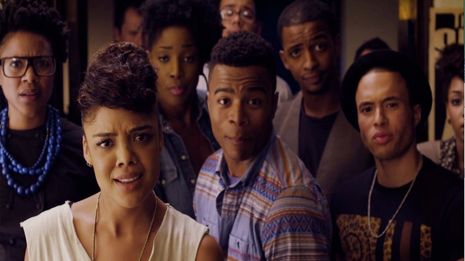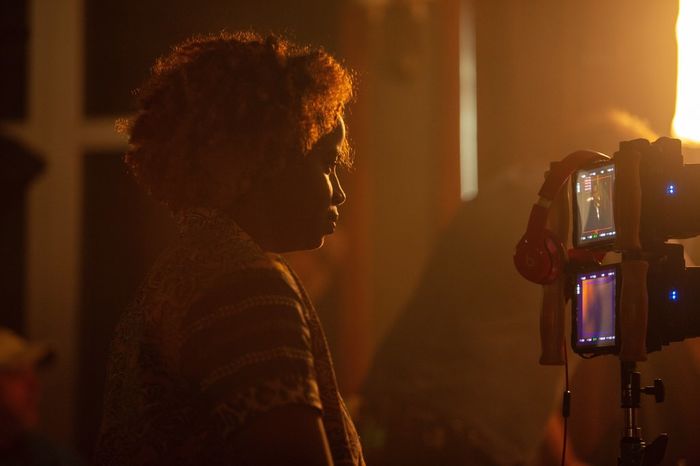White Watching: Encountering White Fragility as a viewer
Guy Webster considers the ways in which White Fragility influences how white audiences watch films that deconstruct Whiteness.

Author and activist, Sonya Renee Taylor has been an important voice among many in contributing to the continuing Black Lives Matter Movement. In her almost daily posts, she encourages her audience to deconstruct what ‘whiteness’ is and how it impacts everyday life. “It’s time’, she says, ‘to talk about Whiteness’. For Renee Taylor, Whiteness refers not just to the shade of one’s skin, but to a system of categorisation that has been carefully constructed, and enforced, over time. Of course, Taylor’s intention is not to encourage us to examine whiteness in film. However, her continuing dissemination of Whiteness, and the ways in which it acts upon us, offers an important lens through which we can, and should, view film.
Conversations about the representation of minority voices on film continue to stress the importance of ‘seeing oneself’ on screen. These discussions are important, and ongoing. They are also relevant for how we conceive of whiteness in film, and the experience of ‘seeing’ that comes with it. In a world within which whiteness is widely – and implicitly – positioned as the assumed centre, the prospect of ‘not seeing’ oneself represented on screen is, for some, an affront. It is in this reaction, and others like it, that we see the influence of White Fragility on how white audiences engage with film.
"It is not a matter of attempting to erase the ways in which racial experience influences how one watches film. Instead, it is encountering these influences head-on"
Watching a film works in terms that make us of an empathetic response. The characters we see, the stories we follow – they not only rely on a loose sense of being able to empathise, but of also being able to identify oneself represented in them as a result. In fact, for black creators and actors, the importance of empathy is a hurdle they must overcome. Speaking in 2005 off the back of his success in Hitch, Will Smith spoke of the economic implications of casting black actors in principle roles. “There’s sort of an accepted myth that if you have two black actors’, Smith told The Birmingham Post, ‘…in the lead of a romantic comedy, that people around the world don’t want to see it’. Whiteness here becomes the assumed audience member who cannot empathise with a character in a film unless they look like them; who will not buy a ticket to a film without them in it. In an article for IndieWire in 2014, Andre Seawood goes further when he writes that ‘A vast majority of White people don’t like Black movies because they lack the empathy necessary’. People of colour, Seawood continues, have consistently been placed in the position as audience members of needing to empathise with white characters. In other words, they have been in positions that require them to either project their experience onto a white character, or sympathise with the character despite the ways in which they differ from them. White audiences are simply less experienced in this practice.
The result of such inexperience is that many white people react with anger when they do not see themselves reflected on screen. Any attempt at inclusivity becomes an affront to the ways in which they experience film. White Fragility creates a wrongful sense of being ‘othered’ simply as a result of not being seen. One need only look to the reception of recent remakes like Ghostbusters, Death At A Funeral, High Fidelity or the upcoming Little Mermaid, to see the ways in which White Fragility informs audience reception. In these examples, the diversity of a cast becomes the implicit motivation for the anger behind ‘hot takes’ that decry all adaptations, or a sense of one’s ‘childhood’ being uprooted.
However, as we learn more about the subtler, more implicit, ways in which racism is perpetuated, we must also consider the equally subtle ways in which Whiteness informs how white people engage with stories that are not immediately relatable to them. It is not a matter of attempting to erase the ways in which racial experience influences how one watches film. Instead, it is encountering these influences head-on and acknowledging how they impact what viewership looks like when relatability is not immediate. It is acknowledging any hurdle you may find in empathising with characters while watching Never Have I Ever, Da 5 Bloods, Girls Trip or Dear White People. It is thinking critically about how Whiteness can inform your perceptions of characters; to actively push back against an apathy to moments that are specific to a culture or race that is unfamiliar to you. It is asking questions that may make your viewership uncomfortable: is it easier to empathise with this character because they are white? Is it easier to view this character as the villain because they are not white? Do I struggle to empathise with this storyline because it is specific to a culture I do not share?
In an interview with Seth Meyers, Allison Williams spoke of her iconic role in 2017's Get Out. Her character in the film stands as a clear representation of the implicitly villainous 'White Liberal'; of the subtler ways in which racial bias is inflicted on people of colour. Of the white audiences she meets, Williams says, many do not believe that her character was a true villain. 'She was hypnotised, right?', they ask. 'No, she's just evil.' The attempt to redeem her character is one many of us, even implicitly, may have faced. For me, this redemption came in trying to separate my Whiteness from the expression of Whiteness put forward by Williams' character. But, as many have been learning, Whiteness is insidious in a myriad of forms - likewise Whiteness on film and my engagement with its representation.

The project of representation – to amplify minority voices – has been wrongfully vilified by many: it is not implicitly exclusionary to white audiences. In fact, increased representation teaches white audiences something invaluable: a new form of empathy that does not require our experience to appear at its centre. This, I believe, is a key steppingstone to de-centring the white experience and coping with the experience of White Fragility – felt as shame, anger or apathy – that impedes progress in all areas, including in film.
 Comment / Plastic pubs: the problem with Cambridge alehouses 5 January 2026
Comment / Plastic pubs: the problem with Cambridge alehouses 5 January 2026 News / Cambridge academics stand out in King’s 2026 Honours List2 January 2026
News / Cambridge academics stand out in King’s 2026 Honours List2 January 2026 News / Cambridge businesses concerned infrastructure delays will hurt growth5 January 2026
News / Cambridge businesses concerned infrastructure delays will hurt growth5 January 2026 News / AstraZeneca sues for £32 million over faulty construction at Cambridge Campus31 December 2025
News / AstraZeneca sues for £32 million over faulty construction at Cambridge Campus31 December 2025 Interviews / You don’t need to peak at Cambridge, says Robin Harding31 December 2025
Interviews / You don’t need to peak at Cambridge, says Robin Harding31 December 2025










